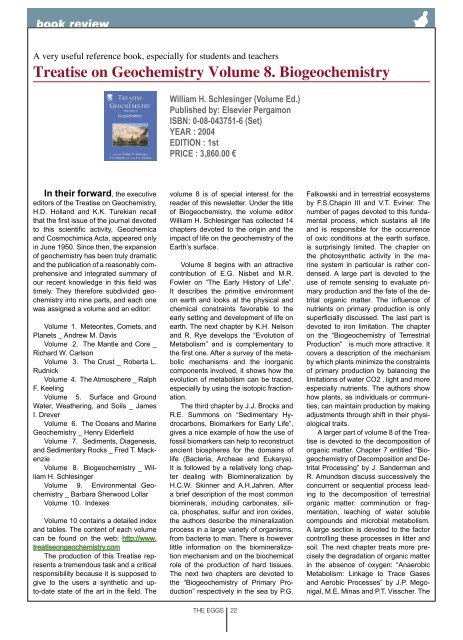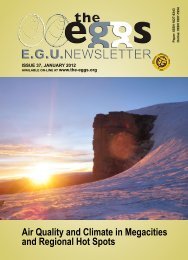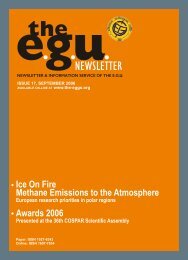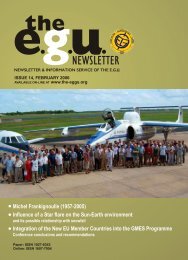Report on the Berlin 2 Open Access Conference - European ...
Report on the Berlin 2 Open Access Conference - European ...
Report on the Berlin 2 Open Access Conference - European ...
You also want an ePaper? Increase the reach of your titles
YUMPU automatically turns print PDFs into web optimized ePapers that Google loves.
A very useful reference book, especially for students and teachersTreatise <strong>on</strong> Geochemistry Volume 8. BiogeochemistryWilliam H. Schlesinger (Volume Ed.)Published by: Elsevier Pergam<strong>on</strong>ISBN: 0-08-043751-6 (Set)YEAR : 2004EDITION : 1stPRICE : 3,860.00 €In <strong>the</strong>ir forward, <strong>the</strong> executiveeditors of <strong>the</strong> Treatise <strong>on</strong> Geochemistry,H.D. Holland and K.K. Turekian recallthat <strong>the</strong> first issue of <strong>the</strong> journal devotedto this scientific activity, Geochemicaand Cosmochimica Acta, appeared <strong>on</strong>lyin June 1950. Since <strong>the</strong>n, <strong>the</strong> expansi<strong>on</strong>of geochemistry has been truly dramaticand <strong>the</strong> publicati<strong>on</strong> of a reas<strong>on</strong>ably comprehensiveand integrated summary ofour recent knowledge in this field wastimely. They <strong>the</strong>refore subdivided geochemistryinto nine parts, and each <strong>on</strong>ewas assigned a volume and an editor:Volume 1. Meteorites, Comets, andPlanets _ Andrew M. DavisVolume 2. The Mantle and Core _Richard W. Carls<strong>on</strong>Volume 3. The Crust _ Roberta L.RudnickVolume 4. The Atmosphere _ RalphF. KeelingVolume 5. Surface and GroundWater, Wea<strong>the</strong>ring, and Soils _ JamesI. DreverVolume 6. The Oceans and MarineGeochemistry _ Henry ElderfieldVolume 7. Sediments, Diagenesis,and Sedimentary Rocks _ Fred T. MackenzieVolume 8. Biogeochemistry _ WilliamH. SchlesingerVolume 9. Envir<strong>on</strong>mental Geochemistry_ Barbara Sherwood LollarVolume 10. IndexesVolume 10 c<strong>on</strong>tains a detailed indexand tables. The c<strong>on</strong>tent of each volumecan be found <strong>on</strong> <strong>the</strong> web: http://www.treatise<strong>on</strong>geochemistry.comThe producti<strong>on</strong> of this Treatise representsa tremendous task and a criticalresp<strong>on</strong>sibility because it is supposed togive to <strong>the</strong> users a syn<strong>the</strong>tic and upto-datestate of <strong>the</strong> art in <strong>the</strong> field. Thevolume 8 is of special interest for <strong>the</strong>reader of this newsletter. Under <strong>the</strong> titleof Biogeochemistry, <strong>the</strong> volume editorWilliam H. Schlesinger has collected 14chapters devoted to <strong>the</strong> origin and <strong>the</strong>impact of life <strong>on</strong> <strong>the</strong> geochemistry of <strong>the</strong>Earth’s surface.Volume 8 begins with an attractivec<strong>on</strong>tributi<strong>on</strong> of E.G. Nisbet and M.R.Fowler <strong>on</strong> “The Early History of Life”.It describes <strong>the</strong> primitive envir<strong>on</strong>ment<strong>on</strong> earth and looks at <strong>the</strong> physical andchemical c<strong>on</strong>straints favorable to <strong>the</strong>early setting and development of life <strong>on</strong>earth. The next chapter by K.H. Nels<strong>on</strong>and R. Rye develops <strong>the</strong> “Evoluti<strong>on</strong> ofMetabolism” and is complementary to<strong>the</strong> first <strong>on</strong>e. After a survey of <strong>the</strong> metabolicmechanisms and <strong>the</strong> inorganiccomp<strong>on</strong>ents involved, it shows how <strong>the</strong>evoluti<strong>on</strong> of metabolism can be traced,especially by using <strong>the</strong> isotopic fracti<strong>on</strong>ati<strong>on</strong>.The third chapter by J.J. Brocks andR.E. Summ<strong>on</strong>s <strong>on</strong> “Sedimentary Hydrocarb<strong>on</strong>s,Biomarkers for Early Life”,gives a nice example of how <strong>the</strong> use offossil biomarkers can help to rec<strong>on</strong>structancient biospheres for <strong>the</strong> domains oflife (Bacteria, Archeae and Eukarya).It is followed by a relatively l<strong>on</strong>g chapterdealing with Biomineralizati<strong>on</strong> byH.C.W. Skinner and A.H.Jahren. Aftera brief descripti<strong>on</strong> of <strong>the</strong> most comm<strong>on</strong>biominerals, including carb<strong>on</strong>ates, silica,phosphates, sulfur and ir<strong>on</strong> oxides,<strong>the</strong> authors describe <strong>the</strong> mineralizati<strong>on</strong>process in a large variety of organisms,from bacteria to man. There is howeverlittle informati<strong>on</strong> <strong>on</strong> <strong>the</strong> biomineralizati<strong>on</strong>mechanism and <strong>on</strong> <strong>the</strong> biochemicalrole of <strong>the</strong> producti<strong>on</strong> of hard tissues.The next two chapters are devoted to<strong>the</strong> “Biogeochemistry of Primary Producti<strong>on</strong>”respectively in <strong>the</strong> sea by P.G.Falkowski and in terrestrial ecosystemsby F.S.Chapin III and V.T. Eviner. Thenumber of pages devoted to this fundamentalprocess, which sustains all lifeand is resp<strong>on</strong>sible for <strong>the</strong> occurrenceof oxic c<strong>on</strong>diti<strong>on</strong>s at <strong>the</strong> earth surface,is surprisingly limited. The chapter <strong>on</strong><strong>the</strong> photosyn<strong>the</strong>tic activity in <strong>the</strong> marinesystem in particular is ra<strong>the</strong>r c<strong>on</strong>densed.A large part is devoted to <strong>the</strong>use of remote sensing to evaluate primaryproducti<strong>on</strong> and <strong>the</strong> fate of <strong>the</strong> detritalorganic matter. The influence ofnutrients <strong>on</strong> primary producti<strong>on</strong> is <strong>on</strong>lysuperficially discussed. The last part isdevoted to ir<strong>on</strong> limitati<strong>on</strong>. The chapter<strong>on</strong> <strong>the</strong> “Biogeochemistry of TerrestrialProducti<strong>on</strong>” is much more attractive. Itcovers a descripti<strong>on</strong> of <strong>the</strong> mechanismby which plants minimize <strong>the</strong> c<strong>on</strong>straintsof primary producti<strong>on</strong> by balancing <strong>the</strong>limitati<strong>on</strong>s of water CO2 , light and moreespecially nutrients. The authors showhow plants, as individuals or communities,can maintain producti<strong>on</strong> by makingadjustments through shift in <strong>the</strong>ir physiologicaltraits.A larger part of volume 8 of <strong>the</strong> Treatiseis devoted to <strong>the</strong> decompositi<strong>on</strong> oforganic matter. Chapter 7 entitled “Biogeochemistryof Decompositi<strong>on</strong> and DetritalProcessing” by J. Sanderman andR. Amunds<strong>on</strong> discuss successively <strong>the</strong>c<strong>on</strong>current or sequential process leadingto <strong>the</strong> decompositi<strong>on</strong> of terrestrialorganic matter: comminuti<strong>on</strong> or fragmentati<strong>on</strong>,leaching of water solublecompounds and microbial metabolism.A large secti<strong>on</strong> is devoted to <strong>the</strong> factorc<strong>on</strong>trolling <strong>the</strong>se processes in litter andsoil. The next chapter treats more precisely<strong>the</strong> degradati<strong>on</strong> of organic matterin <strong>the</strong> absence of oxygen: “AnaerobicMetabolism: Linkage to Trace Gasesand Aerobic Processes” by J.P. Meg<strong>on</strong>igal,M.E. Minas and P.T. Visscher. TheTHE EGGS 22





